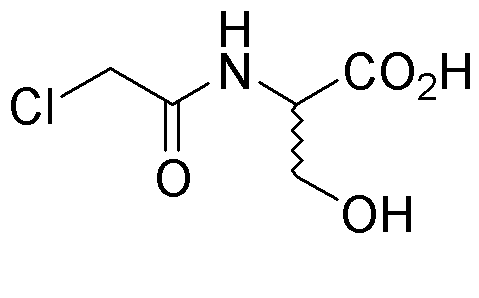Chloroacetyl-DL-serine is widely utilized in research focused on:
- Pharmaceutical Development: This compound serves as a key intermediate in synthesizing various pharmaceuticals, particularly in the development of drugs targeting neurological disorders.
- Biochemical Research: It is used in studies related to enzyme inhibition and protein interactions, helping researchers understand metabolic pathways and disease mechanisms.
- Peptide Synthesis: Chloroacetyl-DL-serine is employed in the synthesis of peptides, which are crucial for developing new therapeutic agents and vaccines.
- Agricultural Chemistry: The compound finds applications in creating agrochemicals, enhancing crop protection products by improving their efficacy against pests and diseases.
- Material Science: It is used in the formulation of specialty polymers and resins, contributing to the development of materials with enhanced properties for various industrial applications.
General Information
Properties
Safety and Regulations
Applications
Chloroacetyl-DL-serine is widely utilized in research focused on:
- Pharmaceutical Development: This compound serves as a key intermediate in synthesizing various pharmaceuticals, particularly in the development of drugs targeting neurological disorders.
- Biochemical Research: It is used in studies related to enzyme inhibition and protein interactions, helping researchers understand metabolic pathways and disease mechanisms.
- Peptide Synthesis: Chloroacetyl-DL-serine is employed in the synthesis of peptides, which are crucial for developing new therapeutic agents and vaccines.
- Agricultural Chemistry: The compound finds applications in creating agrochemicals, enhancing crop protection products by improving their efficacy against pests and diseases.
- Material Science: It is used in the formulation of specialty polymers and resins, contributing to the development of materials with enhanced properties for various industrial applications.
Documents
Safety Data Sheets (SDS)
The SDS provides comprehensive safety information on handling, storage, and disposal of the product.
Product Specification (PS)
The PS provides a comprehensive breakdown of the product’s properties, including chemical composition, physical state, purity, and storage requirements. It also details acceptable quality ranges and the product's intended applications.
Certificates of Analysis (COA)
Search for Certificates of Analysis (COA) by entering the products Lot Number. Lot and Batch Numbers can be found on a product’s label following the words ‘Lot’ or ‘Batch’.
*Catalog Number
*Lot Number
Certificates Of Origin (COO)
This COO confirms the country where the product was manufactured, and also details the materials and components used in it and whether it is derived from natural, synthetic, or other specific sources. This certificate may be required for customs, trade, and regulatory compliance.
*Catalog Number
*Lot Number
Safety Data Sheets (SDS)
The SDS provides comprehensive safety information on handling, storage, and disposal of the product.
DownloadProduct Specification (PS)
The PS provides a comprehensive breakdown of the product’s properties, including chemical composition, physical state, purity, and storage requirements. It also details acceptable quality ranges and the product's intended applications.
DownloadCertificates of Analysis (COA)
Search for Certificates of Analysis (COA) by entering the products Lot Number. Lot and Batch Numbers can be found on a product’s label following the words ‘Lot’ or ‘Batch’.
*Catalog Number
*Lot Number
Certificates Of Origin (COO)
This COO confirms the country where the product was manufactured, and also details the materials and components used in it and whether it is derived from natural, synthetic, or other specific sources. This certificate may be required for customs, trade, and regulatory compliance.


